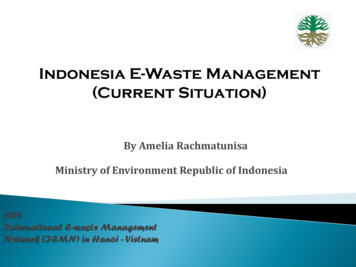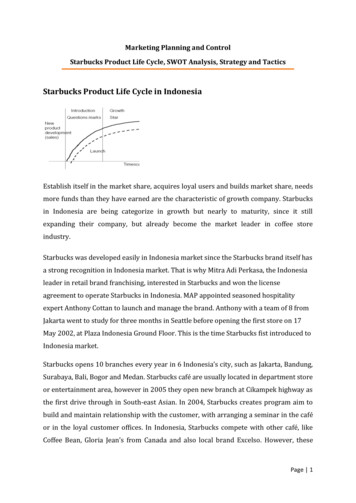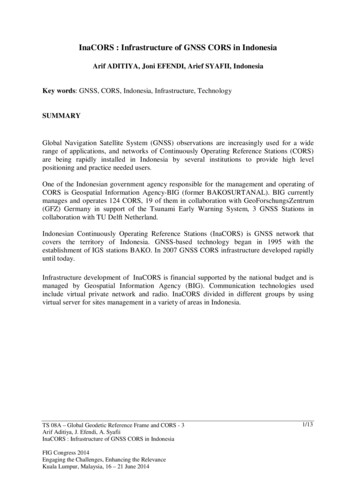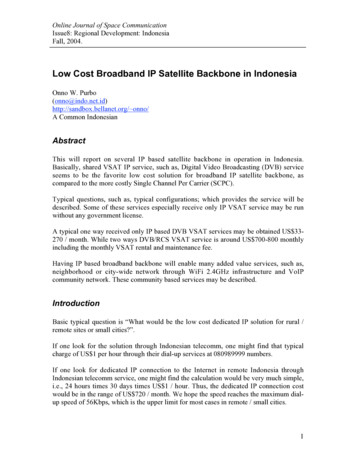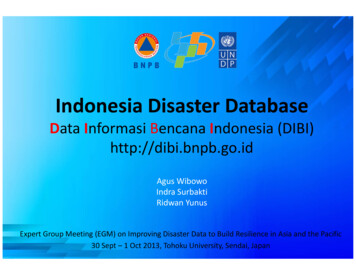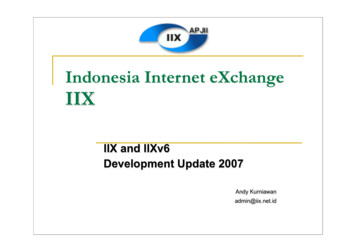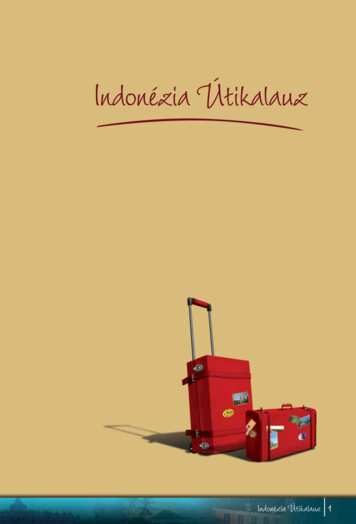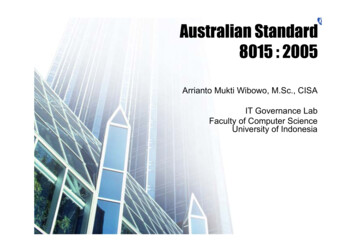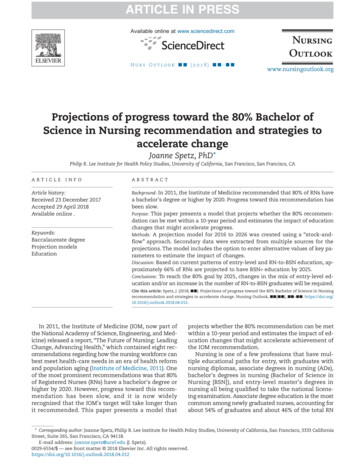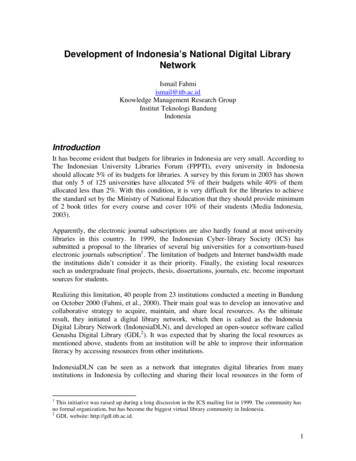
Transcription
Development of Indonesia’s National Digital LibraryNetworkIsmail Fahmiismail@itb.ac.idKnowledge Management Research GroupInstitut Teknologi BandungIndonesiaIntroductionIt has become evident that budgets for libraries in Indonesia are very small. According toThe Indonesian University Libraries Forum (FPPTI), every university in Indonesiashould allocate 5% of its budgets for libraries. A survey by this forum in 2003 has shownthat only 5 of 125 universities have allocated 5% of their budgets while 40% of themallocated less than 2%. With this condition, it is very difficult for the libraries to achievethe standard set by the Ministry of National Education that they should provide minimumof 2 book titles for every course and cover 10% of their students (Media Indonesia,2003).Apparently, the electronic journal subscriptions are also hardly found at most universitylibraries in this country. In 1999, the Indonesian Cyber- library Society (ICS) hassubmitted a proposal to the libraries of several big universities for a consortium-basedelectronic journals subscription1 . The limitation of budgets and Internet bandwidth madethe institutions didn’t consider it as their priority. Finally, the existing local resourcessuch as undergraduate final projects, thesis, dissertations, journals, etc. become importantsources for students.Realizing this limitation, 40 people from 23 institutions conducted a meeting in Bandungon October 2000 (Fahmi, et al., 2000). Their main goal was to develop an innovative andcollaborative strategy to acquire, maintain, and share local resources. As the ultimateresult, they initiated a digital library network, which then is called as the IndonesiaDigital Library Network (IndonesiaDLN), and developed an open-source software calledGenasha Digital Library (GDL2 ). It was expected that by sharing the local resources asmentioned above, students from an institution will be able to improve their informationliteracy by accessing resources from other institutions.IndonesiaDLN can be seen as a network that integrates digital libraries from manyinstitutions in Indonesia by collecting and sharing their local resources in the form of1This initiative was raised up during a long discussion in the ICS mailing list in 1999. The community hasno formal organization, but has become the biggest virtual library community in Indonesia.2GDL website: http://gdl.itb.ac.id.1
metadata and full texts. Through every digital library server, a user can browse, search,and download any resources shared by the IndonesiaDLN members.The growth of this network is significantly fast. Only in two years since the first time thenetwork was launched in 2001, the number of new digital libraries joined theIndonesiaDLN has reached 45 members. They are located at the big five islands, namelyJava, Sumatra, Kalimantan, Sulawesi, and Irian Jaya as shown by Figure 1. Majorities arefrom university and also from NGO, government, and individual.o ACPTUNSYIAH2003o SUPTIAINo SBPTIAINKALIMANTANSUMATRAo SAPTUNSRATo RIPTIAINo JKIKCMCo JKLPNDPDIIo JKPKBPPKo JKPKELNUSAo JKPKFORLINKo JKPKKIHo JKPKLEMHANNASo JKPNPNRIo JKPTBINUSo JKPTBISo JKPTIAINo JKPTPERBANASo JKPTYARSIo JKUNINDFSo JKUNUAJo JIIJKLIBo JIIYPIAo KBPTUNTANo KSPTIAINo SSPTIAINo LAPTIAINSULAWESIo SGPTUNHALUo YOPTIAINIRIAN JAYAo IJPTUNCENo SNPTIAINJAVAo JBKMRGGREYo JBPKBATANo JBPKINSTYo JBPKPBAo JBPKPERSISo JBPKSALMANo JBPTIAINo JBPTITBARo JBPTITBBIo JBPTITBPSUDo JBPTITBTIo JBPTSTIEKESo JBPTUNPADLPo JBPTUPBJJUTBo JBPTUPIo JIPTIAINo JIPTSTIKOMSBYo JIPTUBAYAo JIPTUMMo JIPTSTIKIo JIPTUNAIRo JIPTUNMERFigure 1. The map of Indonesia islands that denotes the location of the IndonesiaDLNmembers. Each member is indicated by its PublisherID, such as ACPTUNSYIAH thatstands for: AC as Aceh (name of the city), PT as Perguruan Tinggi ‘University’ (type ofthe institution) and UNSYIAH as University of Syah Kuala (name of the institution).This initiative is then followed by other initiatives, which developed regional-based orcommunity-based digital library networks. For example, the Environmental DigitalLibrary Network (JPLH 3 ) and Muhammadiyah Digital Library Network (MDLN) areboth community-based digital library networks, which were established in 2003; andPublic University Link System of East Java (PULSE4 ) is a regional-based initiative of 8universities in East Java, which extends its goals to the delivery of educational materialamong its members.This chapter will describe the technical aspect of the IndonesiaDLN, including the basicconcept of the network, metadata standards, metadata exchange protocol with our novelapproach, and implementation. The statistics of its usage, problems, future works, andconclusion also will be uncovered in this chapter.34JPLH website: http://lco.jplh.or.idPULSE website: http://www.pulse.web.id2
Related WorksIn 1996, the National Digital Library of Theses and Dissertations (NDLTD) waslaunched by the Virginia Tech project team to improve graduate education in US. Due towider international interest, the NDLTD was renamed in 1997 as the Networked DigitalLibrary of Theses and Dissertations (Fox, 1999). When we established the IndonesiaDLNin 2000, the NDLTD already had more than 70 members across countries. Theypublished and shared their collections within the network. This shows that developing aDL is not merely about developing an independent system moreover it is a part of aglobal information infrastructure.Many discussions and efforts have been made to develop a DLs framework that can leadto specification of protocols when various components are involved and many DL serversare integrated (Fox, 1999b). For example, Powell (1998) developed a scalable system forsearching heterogeneous multilingual collections on the World Wide Web and the firstproduction was the NDLTD Federated Search. Other initiative that produced a protocolfor metadata harvesting over various repository configurations is the Open ArchiveInitiative (OAI). The OAI Protocol for Metadata Harvesting (OAI-PMH) provides anapplication- independent interoperability framework based on a metadata harvestingmechanism (OAI, 2003). The protocol has been developed since 1999 and the latestversion, protocol version 2, has been released in February 2003. The numbers ofinstitutions that adopt the protocol are increasing by years.Since the OAI-PMH focuses on the harvesting metadata from a data provider, it requiresthe data provider to be connected to the Internet for 24 hours a day. If the IndonesiaDLNadopted the protocol without any modification, most of its members will not be able tojoin the network. More than 50% of them are connected to the Internet using dial- upconnections or located behind proxy servers. Thus other members won’t be able toharvest their metadata due to the unpredicted availability of the servers.One year before IndonesiaDLN was established in 2000, there had been a virtual librarynetwork initiative, which was called the Indonesian Christian University Virtual Library(InCU-VL5 ). This network was originally for the Christian universities community,which was pioneered by the Petra Christian University in Surabaya. Then in 2003, it wasknown as SPEKTRA Vir tual Library (SVL 6 ) after it broadened the scope of its members.Institutions can join the SVL by buying and using the New SPEKTRA proprietarysoftware. Nowadays, there is no automatic mechanism for the institution’s SVL server tosynchronize its metadata to other SVL servers. The process of creating union database isby uploading database record through online web interface manually.Concept and Design56InCU-VL website: http://incuvl.petra.ac.idSVL website: http://svl.petra.ac.id3
Societies or communities that become targets of the IndonesiaDLN are individuals andinstitutions that want to share and get knowledge through the network. They are notlimited only from the academic and research communities, but any parties that want tojoin the knowledge sharing initiative can become member. Currently, communities thathave expressed their interest to join the network are schools, universities, researchinstitutions, NGOs, governmental institutions, public organization, Small and Mediumscale Enterprise (SME), etc.Their knowledge domains are heterogeneous, including children education, heritage,agriculture, health, theses and dissertations, environment, etc. Thus, the digital resourcesalso vary including texts, audios, video, images, source codes, etc. As long as theresources were created, owned, or the copyright allows these resources to bedisseminated publicly, then IndonesiaDLN will accept the resources.The Network ModelThe IndonesiaDLN network model was designed to motivate and enforce communities tojoin the knowledge sharing initiative. The concept was based on a psychological aspect oftheir communication nature. Usually, people from the same community will havefrequent interaction among them rather than with people from other communities. Insteadof inviting them to join into one big network, we suggest them to develop their ownnetworks that consist of their community members. They can be grouped together into acluster network according to their knowledge domains or regions. For example, there willbe networks of Agriculture, Health, Children, East Java Universities, and so on.IndonesiaDLN will act as the bridge for these networks.Each cluster will manage its own activities, including registration of new nodes,managing users, maintaining cluster hub server, socialization of the knowledge sharinginitiative, and provide services to its users. By bringing these administrations to thecluster level, in turn it will decrease the workload at the central network of theIndonesiaDLN.The IndonesiaDLN finally will consist of networks of digital libraries, or become anetwork of networks, as shown by Figure 2. In this example, IndonesiaDLN consists of acentral hub server and nine cluster networks including children, human rights, heritage,Electronic Theses and Dissertation (ETD), school, religion, environment, health, andagriculture. The central hub server acts as a bridge for the knowledge exchange amongthe cluster networks or knowledge islands.The Figure also shows the example of an ETD cluster network. This cluster consists ofnine university nodes, four individual nodes, and an Internet café. It has one cluster hubserver that bridges their resource exchanges.4
Figure 2. The IndonesiaDLN bridges the networks of digital libraries. This model iscalled the Network of Networks.How It Works?This section describes in more detail how the networking model of the IndonesiaDLNsystem above works.Metadata and ResourcesA DL system manages digital resources such as documents, images, audios, videos, orsource codes. Every resource consists of one or more files that are represented by onemetadata. In practice, metadata is defined as a structured set of descriptive elements todescribe an information resource or any definable entity.We use the Dublin Core metadata specification to describe the digital resources. Thisspecification contains 15 element terms, i.e. Title, Creator, Subject, Description,Publisher, Contributor, Date, Type, Format, Identifier, Source, Language, Relation,Coverage, and Rights (DCMI, 2003). In our implementation, we add several subelements to accommodate more detailed information about the resource.5
Figure 3. A metadata in XML format provides short description about a digital resourceand links to its related files.We use XML format to encode the metadata as shown by Figure 3. This metadataexample describes a children’s drawing (image) entitled Zebra bermimpi tentang kebunbinatang ‘A zebra is dreaming about a zoo’ (title) that contains two image files (relation).The metadata also provides other information such as creator, publisher’s identifier,subject, description, contributor’s email, date, metadata’s identifier, source, language, andrights.6
IdentifierThe example of metadata in Figure 3 also describes important information aboutidentifiers. There are two identifiers, publisher’s identifier (e.g. JBKLISMAIL) andmetadata’s identifier (e.g. jbklismail-gdl-image-2003-ainunsabil-2).Every node (publisher) in the IndonesiaDLN should have a unique identifier, which isrequired when it exchanges metadata with other nodes. We follow the existing librarycode convention that is suggested by the National Library of Indonesia to identify everylibrary using a unique code. The code contains information about the library’s location,type of its institution, and its institution name. For example JBPTITB is the code for ITBCentral Library, where JB stands for Jawa Barat ‘West Java’ (location), PT forPerguruan Tinggi ‘University’ (type), and ITB for Institute of Technology Bandung(name). Thus, JBKLISMAIL in the metadata example stands for Jawa Barat (location)Keluarga ‘Family’ (type), and Ismail (institution or individual name).The construction of a metadata identifier, for example in jbklismail-gdl-image-2003ainunsabil-2, also uses the publisher’s identifier (source). The metadata identifiercontains information about its sources (e.g. jbklismail), digital library software name (e.g.gdl ‘Ganesha Digital Library’), type of the resource (e.g. image), year of creation (e.g.2003), creator’s name (e.g. ainunsabil), and the serial number of its creation (e.g. 2).With this naming model, it would be fast and easy to grab important information of ametadata only from its identifier.The Implementation of the OAI Requests and Responses ProtocolWe only disseminate metadata which size is much smaller that the original resource’s filesize, while the resource files will remain at the original server. If the original server is notconnected in 24/7, administrator can upload the files into its hub server.Figure 4 shows how the metadata and files are stored and exchanged. This Figureillustrates an example of a cluster network in the IndonesiaDLN. It consists of a hubserver and three node servers (A, B, and C).
Through every digital library server, a user can browse, search, . connections or located behind proxy servers. Thus other members won’t be able to harvest their metadata due to the unpredicted availability of the servers. One year before IndonesiaDLN was established in 2000, there had been a virtual library network initiative, which was called the Indonesian Christian University Virtual .
